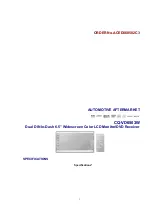
Operation and Maintenance
185
Aastra 415/430 as of R3.2
syd-0344/1.6 – R3.2 – 09.2014
guages for the user interface and online help, language files for Aastra 6700i and
Aastra 6800i-series SIP phones as well as an external numbering plan for SIP con-
nection. Moreover, with the file browser you have the possibility to view, upload,
replace or delete the folders and files in the file system. The file system can also be
accessed with an FTP client (see also
"File management", page 177
).
Functions for backing up and restoring configuration data and audio data are avail-
able in the WebAdmin view
Maintenance
/
Data backup
(
=um
) (see also
"Data
backup", page 179
).
Note:
Modifying or deleting files on the file system of the communication
server can result in a system that is no longer able to run.
6. 1. 1. 3
Boot software
The boot software is stored in a different Flash memory, which allows the commu-
nication server to start up in the boot mode, even if without executable system
software.
6. 1. 1. 4
System-specific data
The system-specific data (system ID, system type, sales channel, licence code, gen-
eration, DECT identification numbers, IP address of the communication server) is
stored on the EIM card (chip card). This data is not deleted by a first start of the PBX,
and remains available. It can be ported to a different communication server by re-
placing the EIM card.
6. 1. 2
Updating configuration data
There are system-wide, user-related and terminal-related configuration data:
• System-wide configuration data can only be modified with WebAdmin.
• Terminal configuration data such as key assignments or ringing melodies can be
modified either directly on the terminal, with Self Service Portal or with
WebAdmin. With some system phones configuration is also possible using the
web user interface or with the help of configuration files.
• User-related configuration data such as private contacts or CFUs is valid for all
the terminals assigned to the user and can be configured using WebAdmin,
partly via Self Service Portal, or directly on the terminal itself.
















































